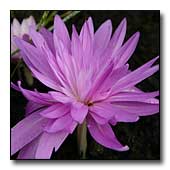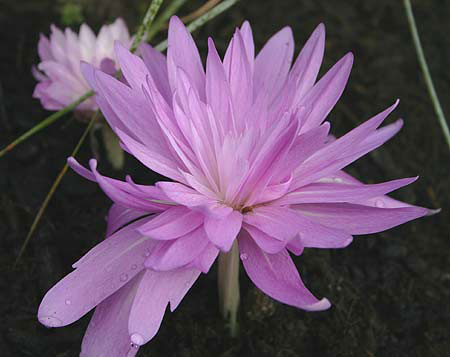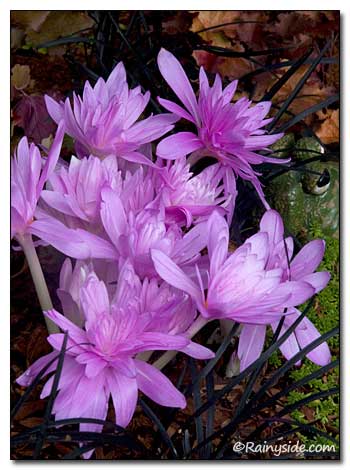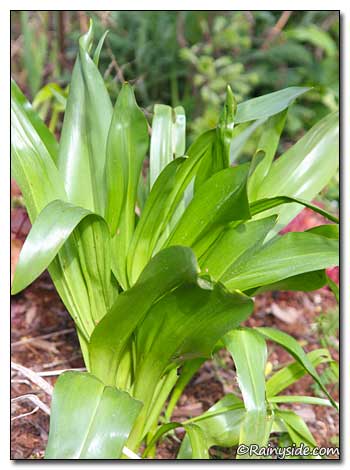Colchicum 'Water Lily'
AUTUMN CROCUS
Family: Liliaceae
Pronounced: KOHL-chi-kum

Quick Jumps
Growing Guide
Rainy Side Notes
GROWING GUIDE

Origin:
Garden.
Plant Group:
Bulbs.
Hardiness:
Sunset zones: 2-10, 14-24.
USDA zones: 4-9.
Mature size:
Height: 5 inches (13 cm).
Flowering period:
Autumn.
Flowering attributes:
Lavender-pink, fully double flowers.
Leaf attributes:
Seven to ten-inch long, narrowly ovate leaves.
Light:
Full sun.
Soil:
Deep, humus rich, moist, well-drained soil.
Feeding:
Fertilize at planting time and in the spring, with a complete organic fertilizer.
Propagation Methods:
Dig up and separate corms in summer and replant.
Pests and Diseases:
Gray mold and slugs may be a problem, although neither has troubled my plants.
Rainy Side Notes


Imagine the sight of Colchicum 'Water Lily' blossoming in your autumn garden. These stunning flowers, often mistaken for autumn crocus, are actually members of the lily family—Liliaceae. In spring, they grace the garden with their seven to ten-inch long, narrowly ovate leaves, which feed the bulb until July. Then, in early fall, the leafless stalk gives birth to an ample double, lavender-pink flower, creating a striking floral scene that lasts for weeks in the autumn garden.
This colchicum cultivar came to my garden from a generous gardening friend, who dug up the whole plant while in bloom and separated the bulbs. Digging them while they are flowering or in leaf is not a recommended practice; however, she knew how to handle this without harming them, and now I have plenty in the garden. For others, without her magic touch, and myself, we divide the bulbs while they are dormant. This involves carefully digging up the bulbs, separating them, and then replanting them in the desired location.
It's crucial to remember that all parts of colchicums, including the bulbs and seeds, are toxic to humans and animals due to the alkaloid, colchicine. This compound can cause serious health issues, including skin irritation upon contact with the corms. Therefore, always use gloves when handling colchicums to ensure your safety.
The historical uses of Colchicum 'Water Lily' are as fascinating as they are varied. Dioscorides (50-79 A.D.) used an extract from the species leaves, soaked in wine, to 'dissolve tumors and growth.' Pliny (23-79 A.D.) and Ibn Sina (980-1037) A.D.) believed in its efficacy, while others, such as Galen (129-210 A.D.), did not. The plant's side effects, including nausea, vomiting, lack of appetite, and hair loss, led some to view it as a poison.
In modern medicine, it is now known that colchicine, the alkaloid found in colchicums, is highly effective against certain malignancies. This makes colchicums a valuable resource in the fight against cancer. Additionally, colchicums are also used in plant genetics. The colchicine found in these plants has the unique ability to double chromosomes, a process known as polyploidization, which is important in plant breeding and genetic research.
When planting out colchicums, it's important to do so three inches deep and six to eight inches apart. This should be done as soon as they arrive and before they bloom. Once planted, it's essential to allow the leaves to come up in spring and remain intact until they die back to the ground. Cutting the leaves back too soon will rob the bulbs of needed nutrients. It's also important to lift and divide the bulbs while they are dormant every three to four years before they become overcrowded. This involves carefully digging up the bulbs, separating them, and then replanting them in the desired location.
Photographed in author's garden.
A Pacific Northwest Plant of the Week (2013)

Gardening for the Homebrewer: Grow and Process Plants for Making Beer, Wine, Gruit, Cider, Perry, and More
By co-authors Debbie Teashon (Rainy Side Gardeners) and Wendy Tweton
Copyright Notice | Home | Search | Bulbs

